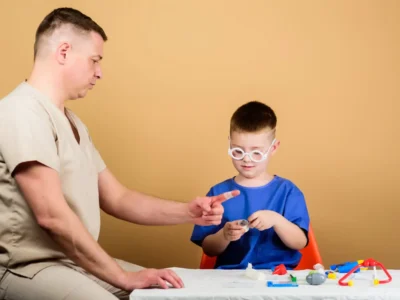The psychologist Anali Naranjo García explores in this article the importance of focusing on the development of executive functions as a means to improve emotional self-regulation in children and adolescents, analyzing both the biological bases of these skills and their influence on the self-regulation process.
To better understand this concept, we can imagine our body as the carriages of a train, where a main conductor controls the movement, braking and direction of all the other carriages. Similarly, our brain operates with the so-called “executive functions”. These skills, according to Muriel Lezak (1989), are defined as “the mental skills that allow the formulation of goals and the planning necessary to carry out an effective, creative and socially acceptable behavior.”
What role do executive functions play in emotional self-regulation?
Emotional self-regulation, defined as the ability to manage emotions so that appropriate and adaptive behaviors are expressed in the face of emotionally intense situations, emerges as a crucial component in psychological well-being. Furthermore, emotional self-regulation has been shown to act as a protective factor against anxiety and depression.
Right Now well, in relation to what was explained in the previous paragraph, all the Actions that allow us to make accurate decisions, act with caution and control the intensity of our reActions originate in the development of executive functions. Therefore, skills such as response inhibition, cognitive flexibility and planning will be essential to respond more adaptively to the different emotions we experience.
Emotional regulation is much more than recognizing and controlling emotions
Child self-regulation is based on a complex interaction between different brain regions and neurological systems. The gradual development of these structures and neurological functions allows children to regulate their emotions and behaviors increasingly effectively throughout childhood and adolescence. It is therefore imperative to focus initial intervention not only on the visual recognition of emotions, but on various skills that directly impact the different executive functions, in order to work systematically according to each developmental stage.
What systems of our brain are involved in executive functions?
The prefrontal cortex is the area in our brain that sets us apart from the primitive brain, that allows us to make decisions, develops our metacognition and enables us to adapt to living in society. That is, it is the area that regulates the signals sent by the amygdala and allows us to assign socially appropriate meanings to each context.
Let’s give an example: when stumbling into someone, the first impulse might be to get angry and push back, responding to fear and/or anger and the survival instinct. However, the development of behavioral inhibition will allow us to pause briefly to think about what actually happened, helping us determine whether it was just an accident. Therefore, the response will tend to be much more peaceful and controlled.

Subscribe
to our
Newsletter
Which executive functions are the main players in emotional regulation?
Again, let’s think of the train operator. Route planning will allow the operator to know the train’s stops, where it will arrive and in how much time. In humans, the ability to plan our behavior allows us to know the steps we must follow to achieve something, how we should do it and how long it will take. Working tasks in steps, taking breaks, setting realistic goals and determining the time for an action is a fundamental support when facing frustration, since we will always know where to start and what to do to complete that task.
Right Now imagine that the train operator encounters a major difficulty mid-route. A large rock has fallen onto the tracks and going over it is not an option. Here the option is to inhibit the train’s movement. That is, to pause movement in order to make the best decision, proceed cautiously, understanding that acting on impulse would have very negative Consequences. This relates to response inhibition, which is the ability to regulate the behavioral manifestation we may have in response to a certain emotion and/or situation.
Response inhibition in children, adolescents and young adults is very challenging. This is because it requires the prefrontal cortex to be developed, which will be fully mature by the age of 25. However, activities such as the self-control traffic light, self-instructions, the conscious practice of making decisions, or reinforcing conflict resolution skills help to effectively develop this ability.
On the other hand cognitive flexibility also plays a fundamental role in emotional self-regulation, since it allows the person to consider various reActions to a situation, different solutions to the same problem and the acceptance of the unpleasant emotion.
Developmental progression and intervention strategies
The development of executive functions evolves across the different stages of life, requiring intervention approaches adapted to each age. In early childhood, activities that promote the inhibition of impulsive responses foster social skills such as waiting, taking turns and tolerance to frustration. In later stages, strategies such as activity planning, conflict resolution and the establishment of structured routines are effective for strengthening executive functions and, therefore, emotional self-regulation.
At-home strategies to strengthen executive functions
- Plan a picnic or outing, making a list of everything needed and the steps to follow to reach the destination.
- Use visual sequence supports for activities like brushing teeth, packing the school bag or washing hands.
- Play the ‘traffic light’ game indicating that you can only move when they say ‘green’, walk slowly when they say ‘yellow’ and stop when they say ‘red’.
- Play ‘giant dwarf’.
- Play board games that encourage waiting turns and controlling the speed/intensity of movement. For example: Crazy Monkeys, Jenga or Twister.
- Use a ball that symbolizes conversational roles. Whoever has the ball has the turn to speak; the others must wait until they finish.
- Play at turning unconventional objects into fun toys. For example: a cardboard box, an old cooking pot or fabric to create clothes for dolls.
- Take a shopping list to the supermarket in which you check off each product you find. If a product is not available, encourage the child to suggest a similar alternative product.
Conclusions and recommendations
This analysis highlighted the importance of developing executive functions as a means to improve emotional self-regulation in children and adolescents. It emphasizes the relevance of addressing this process in a way adapted to each developmental stage, using effective strategies both in educational settings and at home. It also underscores that not only is it necessary to teach the different emotions and how to manage them, but an integral approach to all the different processes behind this skill is required.
Bibliography
- Rueda MR, Paz-Alonso PM. Las funciones ejecutivas y el desarrollo afectivo. En: Tremblay RE, Boivin M, Peters RDeV, eds. Morton JB, ed. tema. Enciclopedia sobre el Desarrollo de la Primera Infancia [en línea]. https://www.enciclopedia-infantes.com/funcionesejecutivas/segun-los-expertos/las-funciones-ejecutivas-y-el-desarrollo-afectivo. Published: January 2013 (English). Accessed February 26, 2024.
- Introzzi, I. & Canet Juric, L. (comp.) (2016). Who holds the baton? Executive Functions: tools for the regulation of the mind, emotion and action.
- Andrés, M., Castañeiras, C., Stelzer, F., Canet Juric, L., & Introzzi, I. (2016). Executive Functions and Emotion Regulation: evidence of their relationship in children. Psicología Desde el Caribe, 2(33), 169-189. DOI: http://dx.doi.org/10.14482/psdc.33.2.7278.
If you liked this article about the why we should primarily work on the development of executive functions to improve emotional self-regulation in children and adolescents, you will likely be interested in these NeuronUP articles:
“This article has been translated. Link to the original article in Spanish:”
¿Por qué debemos trabajar principalmente en el desarrollo de las funciones ejecutivas para mejorar la autorregulación emocional en niños y adolescentes?







 Neurodevelopment: Understanding the diagnosis of autism spectrum disorder (ASD) and attention-deficit/hyperactivity disorder (ADHD)
Neurodevelopment: Understanding the diagnosis of autism spectrum disorder (ASD) and attention-deficit/hyperactivity disorder (ADHD)
Leave a Reply